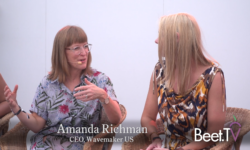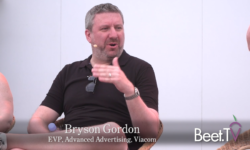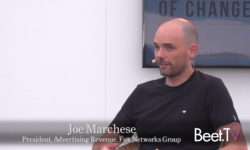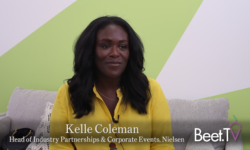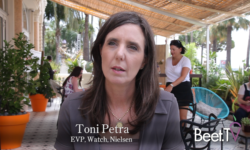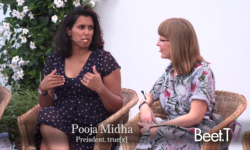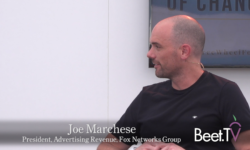CANNES — Together, they have partnered to raise the bar for addressable TV advertising, the new practice through which ad buyers can target viewers down to the household level. So, what do Sky and Finecast think is the future for addressable?
Sky is the UK’s leading pay-TV provider, whose AdSmart was one of the world’s first and biggest addressable TV services. Finecast is GroupM’s agency aiming to be a single point of access to buy inventory across multiple UK TV platforms and operators, including Sky.
In this Beet.TV discussion panel, Sky advanced advertising group director Jamie West and Finecast CEO Jakob Nielsen say addressable TV won’t kill linear – but could soon gobble the majority of TV ad spending.
EY global advisory leader for media and entertainment Janet Balis led the discussion…
Addressable moves the needle
West and Nielsen said they have numbers to prove how addressable TV advertising works.
Sky’s West: “In ad breaks where there is an addressed client, channel switching … reduces by more than a third. that means more relevance or engaged audiences, and that’s a win for the advertiser; that’s a win for the consumer.”
Finecast’s Nielsen: “Advertisers today are starting to struggle just to get their reach across in the linear environment. Wherever you are in the world, linear is declining. Ten years ago the way we watched TV was in front of a box. We didn’t have distractions as we have today. If you are an advertiser and there are too many distractions for you that’s not going to work.”
TV’s not dead
The future will not be wholly on-demand. Whilst addressable can drive brands’ business, there will still be a role for traditional TV, the pair said…
Sky’s West: “I don’t think that linear TV is dead. What a marketeer is trying to do when they use TV is build brand fame. You will still do that using TV, whether it be on-demand or through linear. Addressable makes TV more relevant; it allows you to customize the message; it allows you to understand, household-to-household, the efficacy of your campaign, which means that you can optimize, prioritize and sequence campaigns through that process.
Finecast’s Nielsen: “We don’t think addressable TV will be 100% (of TV ad spend). We think traditional, live, linear TV is very, very important. You still have an tremendous amount of clients that needs to keep investing in their brands and do the reach. The small companies can disrupt your business very, very much if you forget to invest in your brand.”
Sky’s West: “I have a very clear line of sight to getting to 65, 70 percent household penetration for addressable by 2020. That is sort of market-leading or world-leading in terms of household penetration.”
Driving addressable adoption
West and Nielsen said it is challenging to drive adoption when brands are thinking short-term. West said the benefits are clear to brand sat the start, it’s just institutional adoption that needs education…
Finecast’s Nielsen: “Today companies are unfortunately becoming more and more short-sighted; there’s more and more pressure on P&Ls; there’s a tremendous amount of disruption in the market, whatever industry you are in, (your value) could replicated if you don’t have a powerful band. Clients are more and more focused on the short-term. I think that’s a really, really dangerous trend. I think we are doing what we can to kind of keep educating.”
Sky’s West: “What we’ll see is that the market will coalesce around a common standard and common goals, and that’s when you’ll really see addressable go from being whatever percent it is of the market today to being the numbers that Jacob talks about. Forty or 50% (of TV ad spend) is eminently achievable, in my mind.”
This video is part of Beet.TV’s coverage of Cannes Lions 2018. For more videos from Cannes, please visit this page.







